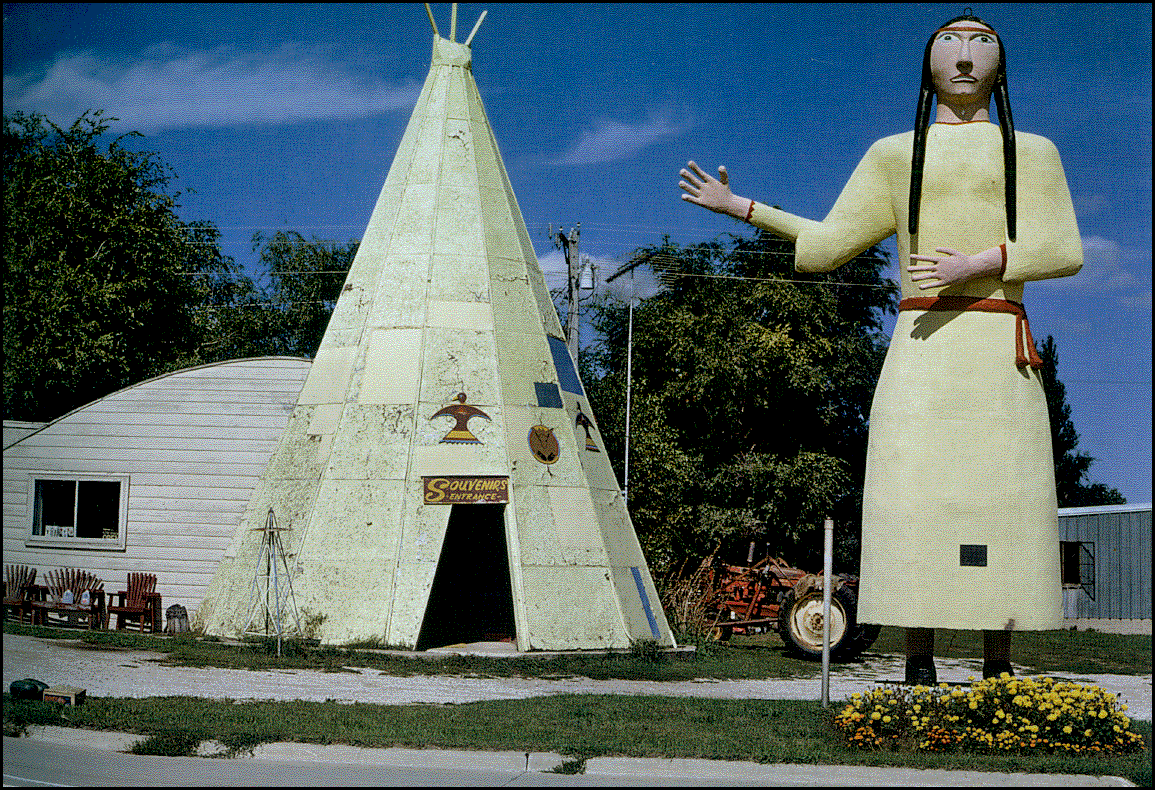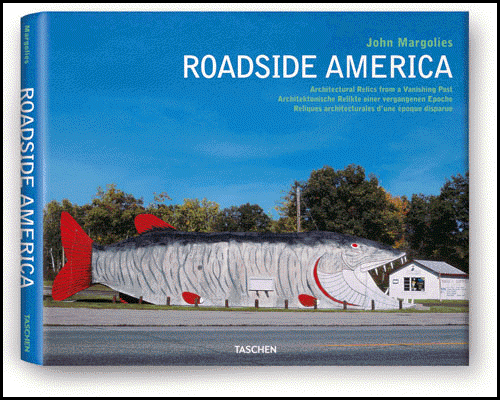
Roadside America
Architectural Relics from
A Vanishing Past
John Margolies
Jim Heimann, Editor
(Taschen
6671 Sunset Bl.
Los Angeles CA 90028)

John Margolies is nuts about weird signs and buildings. For three decades he drove the back highways of America looking for crazy buildings, funny billboards, off-beat neon signs, peculiar figures.If it was a unique theatre, a strange homemade statue, a bizarre storefront, a garish miniature golf course, or any other dotty roadside attraction, he took its picture --- knowing as he did, as we all do, that American does not treasure its treasures. "The Old Spanish Trail," "Highway One," "The Pan-American Highway," "El Camino Real," "The Old Oregon Trail," "Route 66" are the ones we remember, with their alligator parks and souvenir shops and hamburger joints. But this is the land of the free, after all, and those seeking respectability are often eager to junk the eccentric ephemera that made getting from here to there on the old two-lane highways such a gas.
Editor Jim Heimann has done a yeoman's job in collecting over 250 of Margolies' treasures. Oh, the signs: "Thunderbird Restaurant: Home of the Ho-Made Pies" (with colorful eagle); "Guns Dating Back 500 Years" (a smiling Daniel Boone); "Eat It Raw: Half Shell Raw Bar, Key West" (woman in bikini holding up plate); "Howdy Saddle & Spur: Country Music Lounge Dancing Nitely" (cowboy with vest and sombrero); and the unlikely Art Deco building of Guthrie, Oklahoma with the name "R. F. Ringrose, M. D."
The American highways of pre- and post-WWII were jammed with artifacts to attract our attention, so we would pull over in the old Plymouth to get an souvenir under the imposing statue of Chief Passamaquoddy in Freeport, Maine; or down a beer at Geronimo's Castle Tavern in Bowie, Arizona; or to buy something stronger at the Bon Ton Bar in Bay City, Michigan; or even pay for a moist night at the Blue Mist Motel in Miami Beach, Florida. These buildings and signs and drive-ins and cafés and plaster teepees and Indians and bears and dragons and dinosaurs were a sight for sore eyes.The miracle is not that they got built at all --- entrepreneurial America knew no bounds --- but that they lasted long enough for Margolies to immortalize them. The mayors and planning commissions and zoning boards are, as they say in England, "putting paid" to our eccentric past. We all knew that before long the Spindle Parking Lot Sculpture (eight cars impaled on top of each other) in Berwyn, Illinois, or the huge plaster jackrabbit (with saddle) in Texarkana, Texas, or the "Ghost Ship" (a hulking fall-apart wooden sailing boat) in Nags Head, North Carolina, or the fetching sign ("$10,000.00 Reward if not Alive! See Her Change from Girl to Gorilla") in Atlantic City, or the "Dinosaur Slide" in Valle, Arizona will all --- before you can say "Urban Renewal," be long gone --- but memorialized, thank god, by an artist with a camera who was willing to capture rare America before the stone-faced building commissions could lay them to waste.
In his lively "Introduction," Phil Patton reports that Margolies always "got up early to capture blue skies" along with the strange and wonderful objects for his camera. He did his work in the morning. "I love the light at that time of day; it's like golden syrup ... Everything is fresh and no one is there to bother you."Margolies was evidently born with a passion for the garish and out-of-favor. He was an assistant editor at the august Architectural Record in 1970 when he scandalized everyone in the profession by mounting an exhibit in appreciation of Morris Lapidus, the flamboyant architect who designed three Miami Beach hotels ... the Fountainbleu, Americana, and Eden Roc, with their painter's palette shapes, floating ceilings, and sweeping curves.
Having grown up near there, I have fond memories of those pale pink and blue monstrosities which were eyecatchers for the vacationists. We can imagine what the architects of the New Brutalist and International Schools thought of such a tribute. Patton writes that Margolies' "assault on conventional taste"
was followed by an article in Progressive Architecture in praise of the Madonna Inn in San Luis Obispo, California, the well-known garish honeymoon palace where every room is decorated by a theme: stone, redwood, and grotto rooms; the Cloud Nine room; the Victorian Gardens room; the Daisy Mae and Caveman rooms.
Imagine ... your own noisy honeymoon in the Caveman room!
§ § §
Taschen has done Margolies and itself proud in this oversized volume. The "Forword" and "Introduction" appear in English, German, and French. Almost all of the photographs are in glorious color, many lying full across the page, a few in double-spread. And there is no specious text: what we see is what we get.Margolies' fans will appreciate this, for we need no arty commentators to interpret the five massive green dinosaurs at the Indian Rock Shop in Holbrook, Arizona; the many white teepees at the Wigwam Village Motel of Cave City, Kentucky; the stupendous fish-eats-building Big Fish Supper Club in Bona, Minnesota --- which appears on the book-cover --- or the sad black-and-white photo of the fall-apart Coca-Cola shack in Selma, Alabama, taken so long ago: taken by one of the aesthetic twins to Margolies, one Walker Evans.

--- Richard Saturday